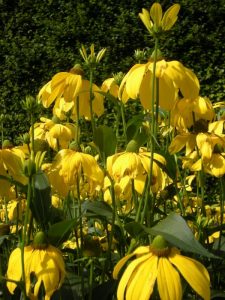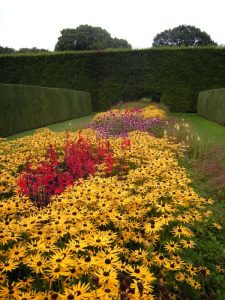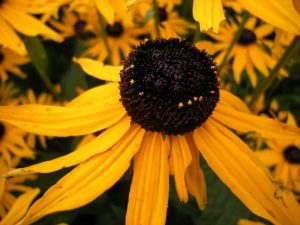Amongst the tallest growing herbaceous plants is Rudbeckia ‘Herbstsonne’, also known in the trade by the English translation, ‘Autumn Sun’. This old cultivar is really only suited to the larger garden, bulking into an extensive clump and touching 3 metres in height. It is often thought to be a cultivar of R. nitida or a cross between R. nitida and R. laciniata, both native to North America.
The petals or ray florets appear curled, pushing taller resembling fingers surrounding the mass of disc florets. Opening as a flat ray, the petals are a bright yellow. As these fade and drop, the cone gains a tint of colour. This is provided by the opening of the anthers, a deep purple in colour and best appreciated through a hand lens. At this stage a slight scent can be detected to attract insects for the pollination process.
Suited to the smaller garden is Rudbeckia fulgida var. sullivantii ‘Goldstrum’, which grows to a more modest 1.2m but still bulks up strongly, as the image shows. This reliable member of the genus provides a storm of golden colour, as the translation recognises.
Its golden yellow ray florets are held on tough, angular, hairy stems. This is lignin production at its best, holding the mass of colour upright through heavy rain and storms.
Which brings us to the rainfall total for August 2008 – a whopping 202.3mm, the highest amount recorded in any month since RBGE started recording weather data. As can be imagined with this amount of rain, sunshine levels for the month are also low at 79.1 hours, with no sun recorded on 7 days; that is almost a quarter of the month with no sun during a period whe we would have expected the bulb collection to receive a summer baking! For more information, see our Edinburgh Weather Station.



